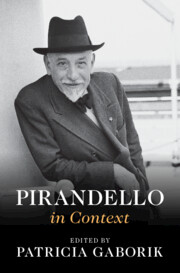Book contents
- Pirandello in Context
- Pirandello in Context
- Copyright page
- Dedication
- Contents
- Figures
- Contributors
- Preface
- Acknowledgments
- Chronology
- List of Cited Titles in Translation and the Original Italian
- Part I Places
- Part II Institutions
- Part III Interlocutors
- Chapter 11 Marta Abba
- Chapter 12 Massimo Bontempelli
- Chapter 13 Gian Francesco Malipiero
- Chapter 14 Georges Pitoëff
- Chapter 15 Max Reinhardt
- Chapter 16 George Bernard Shaw
- Chapter 17 Benedetto Croce and Adriano Tilgher
- Part IV Traditions and Trends, Techniques and Forms
- Part V Culture and Society
- Part VI Reception and Legacy
- Further Reading
- Index
Chapter 13 - Gian Francesco Malipiero
from Part III - Interlocutors
Published online by Cambridge University Press: 14 March 2024
- Pirandello in Context
- Pirandello in Context
- Copyright page
- Dedication
- Contents
- Figures
- Contributors
- Preface
- Acknowledgments
- Chronology
- List of Cited Titles in Translation and the Original Italian
- Part I Places
- Part II Institutions
- Part III Interlocutors
- Chapter 11 Marta Abba
- Chapter 12 Massimo Bontempelli
- Chapter 13 Gian Francesco Malipiero
- Chapter 14 Georges Pitoëff
- Chapter 15 Max Reinhardt
- Chapter 16 George Bernard Shaw
- Chapter 17 Benedetto Croce and Adriano Tilgher
- Part IV Traditions and Trends, Techniques and Forms
- Part V Culture and Society
- Part VI Reception and Legacy
- Further Reading
- Index
Summary
This chapter uses Pirandello’s collaboration with Italian modernist composer Gian Francesco Malipiero on the opera The Changeling as a way into discussing Pirandello’s relationship to and understanding of music more broadly. Several of the author’s short stories, including such works as “Old Music,” “Farewell, Leonora!” – both written in 1910 – and “Zuccarello the Distinguished Melodist,” dating to 1914, make note of shifts in Italian musical taste in that period and therefore suggest a certain attention to music on the author’s part. But Pirandello’s interest in musical vanguardism is perhaps best demonstrated by the fact that he collaborated with Malipiero, a musician so experimental that he was dubbed the “Pirandello of the music scene.” The essay recounts their collaboration as a window onto the two men’s personalities, experimental performance at the time, and the complications for artists and intellectuals who collaborated with the Mussolini regime.
Keywords
- Type
- Chapter
- Information
- Pirandello in Context , pp. 103 - 110Publisher: Cambridge University PressPrint publication year: 2024

